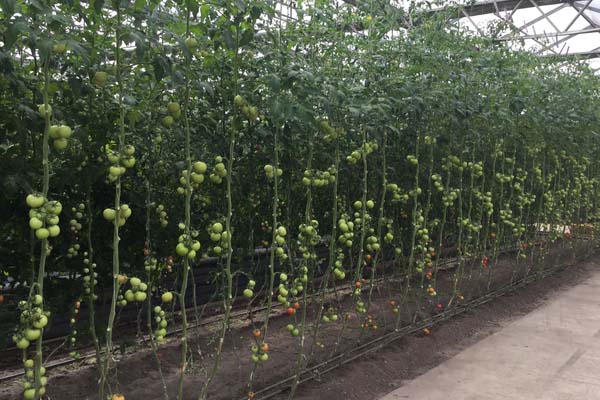- Commercial Greenhouse
- Film Greenhouse
- PC Greenhouse
- Glass Greenhouse
- Tunnel Greenhouse
- Scientific Research Greenhouse
- Vegetable Greenhouse
- Flower Greenhouse
- Multi-span Greenhouse
- Sawtooth Greenhouse
- Greenhouse Equipments
- Greenhouse Accessories
- Hot Dip Galvanized Pipe
- Irrigation System
- Hydroponics System
- Planting Tools
- Planting technology
Tel: +86-28-26388388
Fax: +86-28-26388388
Mobile: +86-180 9638 7750
Contact: Andy
E-mail: sales@cngreenhouses.com
SKYPE:
 live:lee.hungleung
live:lee.hungleung
News Show
Fertilizer's role in agricultural production

Chemical fertilizers in agricultural production and scientific practice to a certain stage of development of natural product. Agricultural production proved that full and rational use of chemical fertilizers to promote crop production and speed up agricultural development in an effective way [1].
An Increase In Crop YieldsIn 1959 and 1980, the state spend a lot of manpower and material resources in the soil survey carried out across the country, and detailed scientific analysis of soil nutrients, agricultural extension workers also is the basis for the use of these soil survey information based on "what the soil to make up what is missing, missing number to make the number of" principle, has launched a balanced fertilization and soil testing andfertilization technologies, establishment of conditions appropriate to the prevailing social conditions and production technology system of crop fertilization. from a single application the development of the nitrogen fertilizer, phosphate fertilizer, and then stabilized by nitrogen and phosphorus plus potassium, NPK composite, K today with the development of efficient, complex, long-term oriented and focus on the use of trace elements, and thus our chemical fertilizer technology has reached a certain stage level [2-3]. to Lishu, for example, grain yields are from the application of fertilizer before the 1 500 ~ 3 000 kg/hm2, and gradually increased to more than 11 250 kg/hm2 . not only solve the problem of national food and clothing, and people's living standard has also been greatly improved. with 9% of the world's arable land, 25% of the total worldproduction ofagricultural products, feed accounts for 22% of the world's population. Fertilizer is food food, according to experts estimated the contribution of chemical fertilizers on grain yield was 50%.
Therefore ,1998-2008, 11 years, the county's chemical fertilizer (N) from 115 kg/hm2 increased to 200 kg/hm2, the corresponding grain yield increase from the 7.2 t/hm2 to 11.5 t/hm2, straw also increased, not only solve the problem of heating the vast rural areas, and a large numbe of surplus straw to field not only directly but also through the development of animal husbandry had to field the soil fertility of abdominal . Therefore, the majority of farmers has greatly improved the basic understanding of scientific application of fertilizers.
Therefore ,1998-2008, 11 years, the county's chemical fertilizer (N) from 115 kg/hm2 increased to 200 kg/hm2, the corresponding grain yield increase from the 7.2 t/hm2 to 11.5 t/hm2, straw also increased, not only solve the problem of heating the vast rural areas, and a large numbe of surplus straw to field not only directly but also through the development of animal husbandry had to field the soil fertility of abdominal . Therefore, the majority of farmers has greatly improved the basic understanding of scientific application of fertilizers.
To Improve Soil FertilityAgricultural inputs of fertilizer each time, after the harvest when the crop, there are a considerable number of residues in the soil (about 30% nitrogen, about 80% of phosphorus, potassium and about 50%), part of its continued losses through various channels, most of is available Xiacha and future sustainable use of planted crops, and this is easily overlooked after effects of chemical fertilizers. for many years the results of rational fertilization, fertilizer aftereffect will be superimposed, to increase soil available nutrients, and promote increasing crop yields not only to maintain the fertility of arable land,and the more species will be more fat.
The higher yield of crops, the stubble left in the soil and other organic matter are more appropriate the more vigorous microbial activity [4]. According to Lishu Agriculture Technology Promotion Center in 2008 located monitoring of soil, land 0 ~ 20 cm topsoil organic matter content of 2.14% on average, quality of farmland soil survey with a second increase of 1.60% compared with 0.54 percentage points; mean topsoil nitrogen content 0.115 5%, compared with the time of the second soil survey 0.107 0%, a slight increase of 5 percentage points 0.008; total phosphorus content was 0.048%, the second soil survey than when 0.069% Low 0.021 percentage points; total potassium content 2.25%, compared with the time of the second soil survey was slightly lower 2.29% 0.04 percentage points. soil available nitrogen, phosphorus, potassium overall upward trend. In particular, the available phosphorus in the soil than when the second soil survey improved from 2 3 times.
A variety of crops, both high-yielding varieties or low-yielding varieties of grain per unit of outpuz form, must be absorbed from the soil composition and the same amount of nutrient elements. According to the reports of agricultural research sector, per unit area of hybrid rice and compared to conventional rice varieties, yield 1 t of rice per unit area than conventional rice hybrid rice absorb nitrogen more than 27 kg, phosphorus pentoxide 12 kg, potassium 26 kg, thus yielding varieties can be considered to be varieties of high-fertilizer. In essence, high-yielding varieties is able to absorb more nutrients, and turn it into food production species.
greenhouse has 35 years of professional production of greenhouse history, in recent years, the company all staff's unremitting efforts, now developed into a professional conservatory company has some influence.
If you want to know more, please send E-mail to sales@cngreenhouses.com



 Deutsch
Deutsch
 Español
Español
 Français
Français
 Italiano
Italiano
 Português
Português
 日本の
日本の
 한국어
한국어
 العربية
العربية
 български
български
 hrvatski
hrvatski
 česky
česky
 Dansk
Dansk
 Nederlands
Nederlands
 suomi
suomi
 Ελληνικά
Ελληνικά
 हिन्दी
हिन्दी
 norsk
norsk
 Polski
Polski
 Română
Română
 русский
русский
 Svenska
Svenska